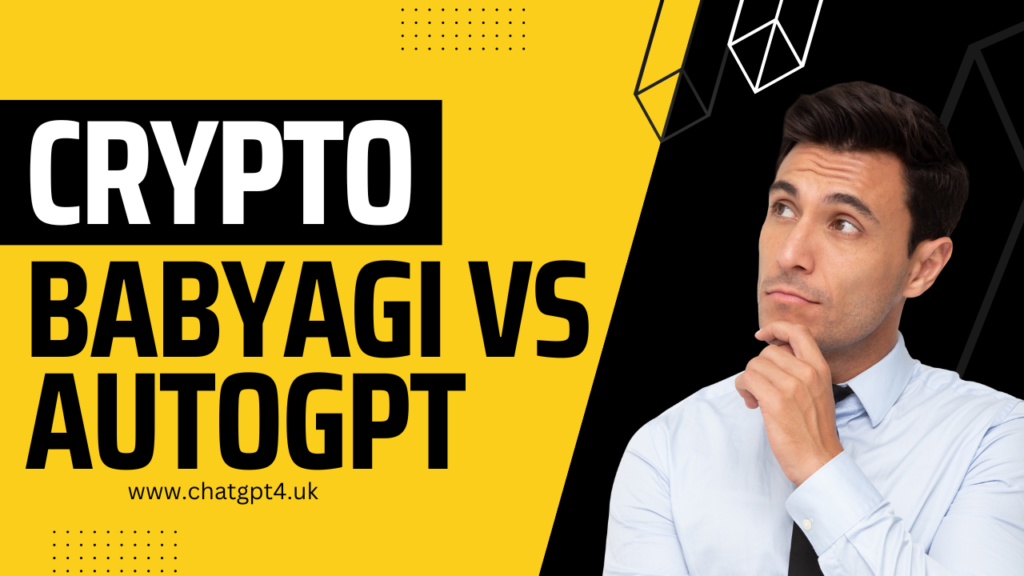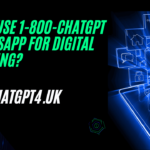Today we are gonna discuss about Cryptocurrency Trading Bots i.e. BabyAGI vs AutoGPT. Cryptocurrency trading has witnessed a surge in popularity, and with it, the demand for advanced trading bots has grown exponentially. In this article, we delve into the intriguing showdown between two cutting-edge AI-powered trading bots: BabyAGI vs AutoGPT.
Both these bots leverage artificial intelligence to execute trades in the volatile cryptocurrency market. We will compare their features, performance, and potential implications for the future of automated trading.
Understanding BabyAGI
a. Introduction to BabyAGI
BabyAGI, short for Baby Artificial General Intelligence, is an advanced AI-powered cryptocurrency trading bot that has gained significant attention in the trading community.
Developed with the goal of achieving artificial general intelligence, BabyAGI combines deep learning, natural language processing, and advanced algorithms to make informed trading decisions in the highly volatile cryptocurrency market.
b. Exploring the capabilities of BabyAGI
- Advanced-Data Analysis: BabyAGI leverages its sophisticated algorithms to analyze vast amounts of historical and real-time market data. It can identify patterns, trends, and anomalies that may indicate potential trading opportunities.
- Decision-Making: BabyAGI utilizes machine-learning techniques to make trading decisions. By continuously learning from its experiences and adapting to changing market conditions, it aims to improve its trading performance over time.
- Risk Management: BabyAGI incorporates robust risk management strategies to protect investments. It considers factors such as position sizing, stop-loss orders, and portfolio diversification to mitigate potential losses and maximize returns.
- Market Monitoring: BabyAGI continuously monitors multiple cryptocurrency exchanges, tracking price movements, order book dynamics, and other relevant market indicators. This allows it to stay updated on market trends and execute trades at optimal times.
- Technical Analysis: BabyAGI incorporates various technical indicators, such as moving averages, RSI (Relative Strength Index), and MACD (Moving Average Convergence Divergence), to identify potential entry and exit points for trades.
c. How BabyAGI learns and adapts to market conditions
- Machine Learning: BabyAGI employs advanced machine learning algorithms to continuously learn and improve its trading strategies. It analyzes historical trading data, identifies patterns, and adapts its decision-making process based on past performance.
- Reinforcement Learning: BabyAGI employs reinforcement learning techniques to reward successful trades and penalize unsuccessful ones. Through a process of trial and error, it fine-tunes its trading strategies to optimize profitability.
- Neural Networks: BabyAGI utilizes neural networks to process and analyze vast amounts of data. These networks are trained to recognize patterns and make predictions based on historical market behavior.
- Adaptive Strategies: BabyAGI dynamically adjusts its trading strategies based on market conditions, volatility, and risk appetite. It can switch between different trading algorithms and adjust parameters to optimize performance in various market environments.
- Real-Time Market Updates: BabyAGI leverages real-time market data feeds to stay updated on changing market conditions. It incorporates news sentiment analysis and social media data to gauge market sentiment and make informed trading decisions.
By combining these capabilities, BabyAGI aims to provide traders with an intelligent, adaptable, and efficient tool for navigating the complex and rapidly changing world of cryptocurrency trading. Its ability to learn from experience and adapt to market conditions positions it as a promising contender in the realm of AI-powered trading bots.
Unveiling AutoGPT
a. Introduction to AutoGPT
AutoGPT is an innovative AI-powered cryptocurrency trading bot that utilizes language models to make trading decisions. Built on the GPT (Generative Pre-trained Transformer) architecture, AutoGPT combines natural language processing and machine learning techniques to analyze market data, interpret textual information, and execute trades in the dynamic cryptocurrency market.
b. Exploring the capabilities of AutoGPT
- Natural Language Processing: AutoGPT excels in understanding and processing human language. It can parse and interpret textual information from various sources, including news articles, social media posts, and financial reports. This enables it to extract valuable insights that may impact cryptocurrency prices and trading opportunities.
- Sentiment Analysis: AutoGPT employs sentiment analysis techniques to gauge market sentiment based on textual data. By analyzing positive, negative, or neutral sentiments expressed in news articles or social media posts, it can assess the potential impact on cryptocurrency prices and adjust its trading strategies accordingly.
- News Filtering: AutoGPT utilizes language models to filter through vast amounts of news articles and other textual sources. It can prioritize relevant news events and filter out noise, focusing on information that is most likely to impact cryptocurrency markets. This helps it make more informed trading decisions.
- Market Analysis: AutoGPT leverages its language understanding capabilities to analyze market trends and patterns. By processing and interpreting textual data related to market behavior, it can identify potential trading signals and make predictions about future price movements.
- Risk Assessment: AutoGPT integrates risk assessment techniques into its trading strategies. By analyzing textual data, it can identify factors that may increase market volatility or pose risks to specific cryptocurrencies. This allows it to adjust its risk management strategies and make more informed decisions to protect investments.
c. How AutoGPT utilizes language models for trading decisions
- Textual Data Processing: AutoGPT employs language models to process and analyze large volumes of textual data related to cryptocurrencies. It can extract relevant information, such as news events, regulatory developments, or market trends, and assess their potential impact on cryptocurrency prices.
- Sentiment-based Trading: AutoGPT utilizes sentiment analysis to gauge market sentiment and make trading decisions based on positive or negative sentiment indicators. For example, if there is positive sentiment surrounding a particular cryptocurrency due to favorable news, AutoGPT may consider opening a long position.
- News-driven Strategies: AutoGPT relies on its language understanding capabilities to develop news-driven trading strategies. It can identify key events or announcements that may impact cryptocurrency prices and automatically execute trades based on the information extracted from textual data.
- Adaptability to Market Conditions: AutoGPT can adapt its trading strategies based on real-time market conditions and emerging textual information. If it detects a sudden change in sentiment or a significant news event, it can swiftly adjust its trading positions to capitalize on opportunities or mitigate potential risks.
- Learning from Textual Data: AutoGPT continuously learns from textual data by leveraging its language models. It can analyze historical data, news articles, and social media posts to identify patterns and correlations between textual information and cryptocurrency price movements. This enables it to improve its trading strategies over time.
AutoGPT’s unique approach of utilizing language models for trading decisions sets it apart in the realm of AI-powered cryptocurrency trading bots. By leveraging natural language processing and machine learning techniques, it aims to provide traders with a sophisticated tool for interpreting textual information and making informed trading decisions.
Performance Metrics
a. Accuracy and profitability comparison of BabyAGI vs AutoGPT
One of the key aspects to consider when evaluating AI-powered cryptocurrency trading bots like BabyAGI and AutoGPT is their accuracy and profitability. These metrics provide insights into the effectiveness of their trading strategies and their ability to generate profits in the volatile cryptocurrency market.
BabyAGI’s accuracy and profitability are determined by its ability to analyze market data, identify trading signals, and execute trades with precision. The bot’s algorithms and machine learning models play a crucial role in its performance. By considering historical price data, technical indicators, and other relevant factors, BabyAGI aims to make accurate predictions about future price movements and generate profitable trading opportunities.
On the other hand, AutoGPT’s accuracy and profitability are closely tied to its language processing capabilities and its ability to interpret textual information. By analyzing news articles, social media posts, and other textual sources, AutoGPT aims to extract insights that can impact cryptocurrency prices and make informed trading decisions based on sentiment analysis and news-driven strategies.
To compare the accuracy and profitability of BabyAGI vs AutoGPT, it is essential to analyze their trading performance over a specific period. This analysis can involve evaluating the frequency of successful trades, the average return on investment (ROI), and other relevant metrics. Additionally, it is crucial to consider factors such as market conditions, the volatility of cryptocurrencies, and the specific trading strategies employed by each bot.
b. Analyzing historical trading data and backtesting results
To gain a deeper understanding of the performance of BabyAGI vs AutoGPT, it is necessary to analyze their historical trading data and conduct backtesting. Historical trading data provides valuable insights into the bots’ performance over a specified period, helping to identify strengths, weaknesses, and patterns in their trading strategies.
Backtesting involves simulating trades based on historical data to evaluate the performance of a trading strategy. By applying their algorithms and models to past market conditions, BabyAGI vs AutoGPT can assess how their strategies would have performed in the past. This analysis helps to validate the effectiveness of their trading approaches and provides an indication of their potential performance in future market conditions.
When analyzing historical trading data and backtesting results, it is important to consider several factors. These include the frequency and accuracy of trades, the risk-adjusted returns, and the consistency of performance across different market conditions. Additionally, it is essential to compare the performance of BabyAGI vs AutoGPT against relevant benchmarks, such as market indices or other established trading strategies.
c. Evaluating risk management strategies employed by each bot
Effective risk management is a critical component of successful trading, especially in the highly volatile cryptocurrency market. Both BabyAGI vs AutoGPT employ risk management strategies to mitigate potential losses and protect investments.
BabyAGI’s risk management strategies may involve setting stop-loss orders, implementing position sizing techniques, or dynamically adjusting trading positions based on market conditions. The bot aims to strike a balance between capital preservation and maximizing profit potential by carefully managing risk exposure.
AutoGPT also incorporates risk management techniques into its trading strategies. By analyzing textual information and market data, it can identify factors that may increase market volatility or pose risks to specific cryptocurrencies. This enables the bot to adjust its trading positions, implement risk mitigation measures, and make informed decisions to protect investments.
Evaluating the effectiveness of risk management strategies employed by BabyAGI vs AutoGPT requires considering factors such as the maximum drawdown (the largest loss experienced), risk-adjusted returns, and the ability to adapt to changing market conditions. Additionally, it is crucial to assess the bots’ ability to react swiftly to unexpected events or market fluctuations, as well as their overall risk tolerance.
By evaluating the accuracy and profitability, analyzing historical trading data and backtesting results, and assessing the risk management strategies employed by BabyAGI vs AutoGPT, traders can gain valuable insights into the performance and capabilities of these AI-powered cryptocurrency trading bots. These performance metrics play a crucial role in determining which bot aligns best with individual trading goals and risk preferences.
Trading Strategies
a. Technical analysis: BabyAGI’s approach to trading indicators and patterns
Technical analysis is a widely used trading strategy that involves analyzing historical price data, chart patterns, and various technical indicators to make trading decisions. BabyAGI incorporates technical analysis into its trading strategy to identify potential market trends and entry/exit points.
Using advanced machine learning algorithms, BabyAGI can recognize patterns in price charts and indicators such as moving averages, oscillators, and support/resistance levels. These patterns help the bot identify potential price reversals, breakouts, or trend continuations, enabling it to make informed trading decisions.
By continuously analyzing and processing vast amounts of historical price data, BabyAGI can recognize recurring patterns that have proven to be indicators of price movements in the past. This allows the bot to generate trading signals based on these patterns and execute trades accordingly.
b. Sentiment analysis: AutoGPT’s utilization of natural language processing for market sentiment
Sentiment analysis is a trading strategy that involves analyzing and interpreting market sentiment derived from textual sources such as news articles, social media posts, and forum discussions. AutoGPT utilizes its natural language processing capabilities to extract valuable insights from these sources and incorporate them into its trading decisions.
By analyzing textual information, AutoGPT can identify positive or negative sentiment towards specific cryptocurrencies or the overall market sentiment. This helps the bot understand market dynamics influenced by news, events, or public opinion. Based on this analysis, AutoGPT can adjust its trading positions, anticipate market reactions, and take advantage of sentiment-driven price movements.
The bot’s language model allows it to process and understand the context of the text, identify key entities, and assess the sentiment associated with them. By monitoring news trends and social media sentiment, AutoGPT aims to gain an informational edge and make trading decisions that align with prevailing market sentiment.
c. Exploration of machine learning algorithms employed by both bots
Both BabyAGI vs AutoGPT utilize machine learning algorithms to enhance their trading strategies and decision-making processes. These algorithms enable the bots to learn from historical data, adapt to changing market conditions, and improve their performance over time.
BabyAGI employs various machine learning algorithms such as recurrent neural networks (RNNs), long short-term memory (LSTM) networks, and convolutional neural networks (CNNs). These algorithms are capable of processing sequential data, identifying patterns, and making predictions based on historical market data.
The bot’s machine learning models undergo continuous training and optimization to improve accuracy and performance. By analyzing vast amounts of historical price data, BabyAGI can learn from past market trends, correlations, and anomalies, enabling it to make more informed trading decisions.
AutoGPT, on the other hand, utilizes advanced natural language processing (NLP) techniques combined with transformer-based language models such as OpenAI’s GPT (Generative Pre-trained Transformer). These models enable AutoGPT to process and understand textual information, extract relevant features, and generate valuable insights for trading decisions.
The algorithms employed by AutoGPT enable it to learn from a wide range of textual sources, including news articles, social media posts, and other online content. By training on large amounts of data, AutoGPT can capture nuanced language patterns and relationships, allowing it to generate accurate sentiment analysis and make informed trading decisions based on textual information.
Adaptability and Market Dynamics
a. BabyAGI’s ability to adapt to changing market conditions
One of the key strengths of BabyAGI is its ability to adapt to changing market conditions. As an AI-powered trading bot, BabyAGI continuously learns from historical market data and adjusts its trading strategies to accommodate evolving market dynamics.
Market conditions can vary significantly over time, with fluctuations in volatility, liquidity, and overall sentiment. BabyAGI employs sophisticated machine learning algorithms that enable it to recognize and adapt to these changes. By analyzing historical data, the bot can identify patterns and correlations that are indicative of different market regimes.
For example, during periods of high volatility, BabyAGI may adjust its risk management parameters to account for increased market uncertainty. It may reduce position sizes or tighten stop-loss levels to mitigate potential losses. Similarly, in low volatility environments, the bot may increase position sizes to capitalize on smaller price movements.
By monitoring real-time market data and continuously updating its models, BabyAGI can quickly respond to changing conditions and adjust its trading strategies accordingly. This adaptability allows the bot to remain competitive and potentially capitalize on emerging market opportunities.
b. AutoGPT’s responsiveness to news events and real-time market sentiment
AutoGPT, with its focus on sentiment analysis and natural language processing, is highly responsive to news events and real-time market sentiment. The bot can quickly process and interpret textual information from various sources, enabling it to respond to breaking news and market-moving events.
News events can have a significant impact on cryptocurrency markets, leading to rapid price movements and shifts in sentiment. AutoGPT can analyze news articles, social media posts, and other textual sources to gauge market sentiment and incorporate this information into its trading decisions.
For instance, if there is breaking news about a regulatory development or a major partnership in the cryptocurrency industry, AutoGPT can swiftly capture the sentiment associated with the news and adjust its trading positions accordingly. Positive news may prompt the bot to take bullish positions, while negative news may lead to more cautious or bearish stances.
The responsiveness of AutoGPT to news events and real-time sentiment provides it with an advantage in capturing market opportunities that arise from such events. By leveraging its natural language processing capabilities, the bot can quickly process and react to information that may impact cryptocurrency prices.
c. Comparing the speed and agility of both bots in executing trades
When it comes to executing trades, speed and agility are crucial factors for AI-powered trading bots. Both BabyAGI vs AutoGPT strive to execute trades efficiently, but their approaches may differ based on their underlying strategies and technical infrastructure.
BabyAGI, with its focus on technical analysis, relies on the analysis of price patterns, indicators, and market data to make trading decisions. Once the bot generates a trading signal, it executes trades based on predefined rules and parameters. The speed of execution depends on factors such as the latency of data feeds and the efficiency of the trading infrastructure supporting the bot.
AutoGPT, on the other hand, emphasizes the analysis of textual information and sentiment. While the bot still needs to process and interpret this information, it may require slightly more time compared to BabyAGI, as it involves natural language processing and understanding. However, the speed of execution can still be optimized by leveraging high-performance computing resources and efficient data pipelines.
It is important to note that the speed of execution is not the sole determinant of a bot’s success. Factors such as accuracy of predictions, risk management strategies, and overall profitability also play crucial roles. A bot that executes trades slightly slower but with higher accuracy and better risk management may outperform a faster but less reliable bot.
Potential Risks and Challenges
a. Addressing risks associated with AI-powered trading bots
While AI-powered trading bots like BabyAGI vs AutoGPT offer numerous advantages, they also come with inherent risks that need to be addressed. It is important to understand and mitigate these risks to ensure the effective and responsible use of automated trading systems.
One significant risk is the potential for technical glitches or system failures. Trading bots rely on complex algorithms and infrastructure to execute trades, and any malfunction or disruption can lead to undesired outcomes. It is crucial to have robust monitoring systems in place to detect and resolve any technical issues promptly.
Another risk is over-reliance on historical data and past performance. While AI algorithms can analyze historical data to make predictions, there is always a degree of uncertainty in financial markets. Overfitting, a phenomenon where a model becomes too closely tailored to historical data, can lead to poor performance in real-world conditions. Regular model validation and testing against current market conditions are necessary to ensure the efficacy of the trading strategies.
b. Discussing the challenges of over-optimization and market manipulation
Over-optimization is a common challenge in algorithmic trading and can affect both BabyAGI vs AutoGPT. Over-optimization occurs when trading strategies are excessively fine-tuned to historical data, leading to poor performance in live trading. This can be a result of curve-fitting, where a strategy is tailored too precisely to past market conditions, but fails to perform well in new or evolving market scenarios.
Market manipulation is another challenge that AI-powered trading bots face. Cryptocurrency markets, in particular, are susceptible to price manipulation due to their relatively low liquidity and decentralized nature. Bots that solely react to market sentiment without proper validation of the information source can fall prey to manipulated signals, leading to suboptimal trading decisions.
To address these challenges, developers and traders need to employ rigorous testing methodologies, including out-of-sample testing and stress testing, to validate the robustness and adaptability of the bots. Implementing risk management protocols, such as position sizing limits and stop-loss orders, can also help mitigate the impact of unforeseen market events and manipulative practices.
c. The importance of continuous monitoring and human oversight in automated trading
Automated trading systems should never be left unattended without proper monitoring and human oversight. While AI-powered bots can make quick and data-driven decisions, they lack the intuition and judgment of experienced human traders. Human intervention is crucial for assessing and adapting to extraordinary market conditions or events that may not be adequately captured by the bot’s algorithms.
Continuous monitoring of the bots’ performance and adherence to predefined risk management parameters is essential. Regular reviews of trading strategies and adjustments based on changing market dynamics are necessary to maintain optimal performance. Human traders can also provide additional inputs and insights that can enhance the bots’ decision-making process.
Furthermore, compliance with regulatory requirements is paramount in automated trading. Trading bots need to comply with relevant laws and regulations to ensure fair and transparent trading practices. Human oversight can help ensure that the bots operate within the legal and ethical boundaries of the financial markets.
Ethical Considerations
a. Transparency and accountability in AI-driven trading decisions
Transparency and accountability are crucial ethical considerations when it comes to AI-driven trading decisions. It is essential for users and market participants to understand how the trading bots make their decisions and the factors that influence their actions. This transparency can be achieved through clear documentation and disclosure of the underlying algorithms, data sources, and risk management strategies employed by the bots.
Furthermore, there should be mechanisms in place to hold the developers and operators of AI-powered trading bots accountable for their actions. This can include regular audits and external reviews to ensure that the bots operate within the defined parameters and adhere to ethical standards. By promoting transparency and accountability, trust in the AI-driven trading systems can be fostered among market participants.
b. Potential implications for market fairness and integrity
The use of AI-powered trading bots like BabyAGI and AutoGPT can have implications for market fairness and integrity. It is important to consider whether the widespread adoption of these bots could result in an uneven playing field, where those with access to advanced AI technologies have an unfair advantage over individual traders or less sophisticated market participants.
Market manipulation is also a concern, as the use of trading bots could potentially amplify manipulative practices or create new forms of market abuse. Regulators and market participants need to be vigilant in monitoring for any suspicious activities or behaviors that may compromise market fairness and integrity. Establishing robust surveillance mechanisms and implementing strict enforcement measures can help deter and address any unethical conduct in AI-powered trading.
c. Regulatory frameworks and guidelines for AI-powered trading bots
Given the potential impact of AI-powered trading bots on financial markets, regulatory frameworks and guidelines are crucial to ensure responsible and ethical use. Regulators play a significant role in establishing rules and standards that govern the development, deployment, and operation of these bots.
Regulatory frameworks may encompass areas such as data privacy and security, algorithmic transparency, risk management, and market conduct. These frameworks aim to strike a balance between fostering innovation and ensuring market stability and investor protection. Regulators can collaborate with industry participants, AI experts, and other stakeholders to develop guidelines that address the unique challenges posed by AI-powered trading bots.
By implementing clear and comprehensive regulatory frameworks, regulators can provide market participants with confidence in the ethical use of AI in trading. These frameworks should evolve alongside technological advancements, adapting to new risks and challenges that emerge as AI technologies continue to develop.
Future Outlook
a. Advancements in AI and the potential impact on cryptocurrency trading bots
The field of artificial intelligence (AI) is evolving at a rapid pace, and this has significant implications for the future of cryptocurrency trading bots like BabyAGI and AutoGPT. Advancements in AI techniques, such as deep learning and reinforcement learning, are likely to enhance the capabilities of these bots, enabling them to make even more accurate and informed trading decisions.
With improved AI algorithms, trading bots can potentially analyze vast amounts of data in real-time, identify complex patterns, and adapt to changing market conditions more effectively. This can lead to increased profitability and reduced risks associated with cryptocurrency trading. As AI continues to advance, we can expect trading bots to become even more sophisticated, potentially outperforming human traders in terms of speed and accuracy.
b. Exploring the integration of BabyAGI vs AutoGPT with decentralized finance (DeFi)
Decentralized finance (DeFi) has gained significant traction in the cryptocurrency space, offering innovative financial services without the need for intermediaries. The integration of AI-powered trading bots like BabyAGI and AutoGPT with DeFi platforms presents exciting possibilities for automated and autonomous trading in a decentralized ecosystem.
By leveraging the power of AI, these bots can potentially navigate the complexities of decentralized markets, identify lucrative trading opportunities, and execute trades seamlessly within the DeFi protocols. The integration of AI with DeFi can lead to improved liquidity, enhanced market efficiency, and increased accessibility to advanced trading strategies for DeFi users.
c. The role of AI in shaping the future of the cryptocurrency market
AI is expected to play a transformative role in shaping the future of the cryptocurrency market. As the market continues to mature and evolve, AI-powered trading bots are likely to become essential tools for traders and investors. These bots can provide valuable insights, automate trading processes, and adapt to the dynamic nature of the cryptocurrency market.
Furthermore, AI can help identify emerging trends, predict market movements, and mitigate risks associated with cryptocurrency trading. The ability of AI-powered bots to process vast amounts of data and make data-driven decisions in real-time can potentially lead to more informed and profitable trading strategies.
Moreover, AI can facilitate the development of advanced analytical tools, sentiment analysis algorithms, and predictive models, enabling market participants to make more accurate predictions and optimize their trading strategies. As AI technology continues to advance, we can anticipate the emergence of new AI-driven solutions that revolutionize the way cryptocurrencies are traded and managed.
Conclusion
By exploring the battle between BabyAGI and AutoGPT, we gain insights into the exciting world of AI-driven trading bots and their impact on the cryptocurrency market. These advanced bots showcase the potential of artificial intelligence in automating trading decisions, adapting to market conditions, and potentially revolutionizing the way we trade cryptocurrencies. As the technology continues to evolve, it is vital to strike a balance between innovation, risk management, and ethical considerations to ensure a fair and efficient marketplace for all participants.
FAQs About BabyAGI vs AutoGPT
Q: Are BabyAGI and AutoGPT suitable for beginner traders?
A: Both BabyAGI and AutoGPT can be used by traders of various skill levels. However, beginner traders should have a basic understanding of cryptocurrency trading and risk management before using these AI-powered bots. It is also recommended to start with smaller investment amounts and gradually increase exposure as familiarity with the bots and market dynamics grows.
Q: Can BabyAGI and AutoGPT guarantee profits?
A: While BabyAGI and AutoGPT are designed to enhance trading strategies and decision-making processes, they cannot guarantee profits. The cryptocurrency market is highly volatile and subject to various external factors that can impact trading outcomes. It is important to note that past performance does not guarantee future results, and users should exercise caution and conduct thorough research before relying solely on these bots for trading decisions.
Q: Do BabyAGI and AutoGPT require constant monitoring?
A: While BabyAGI and AutoGPT are automated trading bots, they still require periodic monitoring. Market conditions can change rapidly, and it is essential to ensure that the bots are functioning properly and adapting to the evolving market dynamics. Additionally, monitoring can help identify any technical issues or connectivity problems that may affect the performance of the bots.
Q: Can I customize the trading strategies of BabyAGI and AutoGPT?
A: Both BabyAGI and AutoGPT offer varying degrees of customization for trading strategies. Users can often adjust parameters such as risk tolerance, trading frequency, and asset selection to align the bots with their specific preferences and goals. However, it is important to understand the implications of customizing strategies and consider the associated risks, as improper configuration may lead to undesirable outcomes.
Q: Are there any hidden fees or charges associated with using BabyAGI and AutoGPT?
A: The pricing structures for BabyAGI and AutoGPT can vary depending on the platform or service provider. Some providers may charge subscription fees, transaction fees, or a percentage of profits generated by the bots. It is advisable to thoroughly review the pricing details and terms of service before using these bots to ensure a clear understanding of any associated costs.
Q: Can I use BabyAGI and AutoGPT on multiple cryptocurrency exchanges?
A: The availability of BabyAGI and AutoGPT on different cryptocurrency exchanges depends on the specific integration and compatibility of the bots with those exchanges. Some bots may support multiple exchanges, while others may be limited to specific platforms. It is recommended to check the documentation or contact the service provider to determine which exchanges are supported.
Q: What is the minimum capital required to use BabyAGI and AutoGPT?
A: The minimum capital required to use BabyAGI and AutoGPT can vary depending on the platform or service provider. Some providers may have minimum deposit requirements, while others may allow users to start with smaller amounts. It is important to review the terms and conditions of the service and consider personal financial circumstances before committing capital to these bots.
Q: Can I use BabyAGI and AutoGPT for long-term investing?
A: BabyAGI and AutoGPT are primarily designed for active trading and short to medium-term investment strategies. While they can assist in analyzing market trends and executing trades, they may not be optimized for long-term investment strategies such as buy-and-hold approaches. For long-term investing, it is advisable to complement the use of these bots with comprehensive fundamental analysis and personal judgment.
Q: What security measures are in place to protect my funds and data when using BabyAGI and AutoGPT?
A: Security measures vary among platforms and service providers offering BabyAGI and AutoGPT. It is important to choose reputable providers that implement robust security protocols, including encryption, multi-factor authentication, and secure data storage. Additionally, users should follow best practices such as using strong passwords, regularly updating software, and exercising caution when interacting with suspicious links or emails.
Q: Can I use BabyAGI and AutoGPT alongside manual trading?
A: Yes, BabyAGI and AutoGPT can be used alongside manual trading strategies. These bots can provide valuable insights and analysis to supplement traders’ decision-making processes. However, it is essential to carefully monitor the interaction between manual trading activities and the automated bots to avoid conflicts and ensure consistent trading strategies.







